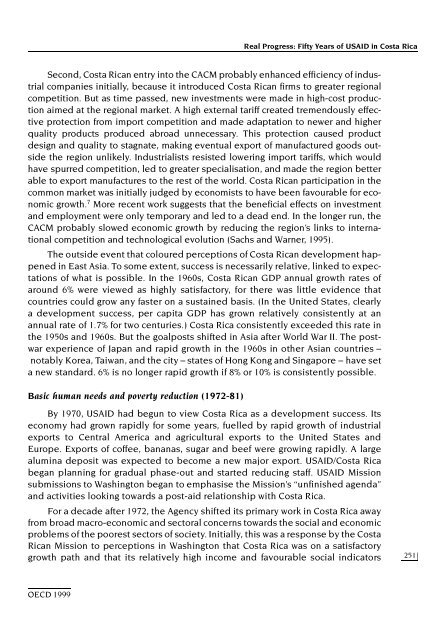Evaluating Country Programmes - OECD Online Bookshop
Evaluating Country Programmes - OECD Online Bookshop
Evaluating Country Programmes - OECD Online Bookshop
You also want an ePaper? Increase the reach of your titles
YUMPU automatically turns print PDFs into web optimized ePapers that Google loves.
<strong>OECD</strong> 1999<br />
Real Progress: Fifty Years of USAID in Costa Rica<br />
Second, Costa Rican entry into the CACM probably enhanced efficiency of industrial<br />
companies initially, because it introduced Costa Rican firms to greater regional<br />
competition. But as time passed, new investments were made in high-cost production<br />
aimed at the regional market. A high external tariff created tremendously effective<br />
protection from import competition and made adaptation to newer and higher<br />
quality products produced abroad unnecessary. This protection caused product<br />
design and quality to stagnate, making eventual export of manufactured goods outside<br />
the region unlikely. Industrialists resisted lowering import tariffs, which would<br />
have spurred competition, led to greater specialisation, and made the region better<br />
able to export manufactures to the rest of the world. Costa Rican participation in the<br />
common market was initially judged by economists to have been favourable for economic<br />
growth. 7 More recent work suggests that the beneficial effects on investment<br />
and employment were only temporary and led to a dead end. In the longer run, the<br />
CACM probably slowed economic growth by reducing the region’s links to international<br />
competition and technological evolution (Sachs and Warner, 1995).<br />
The outside event that coloured perceptions of Costa Rican development happened<br />
in East Asia. To some extent, success is necessarily relative, linked to expectations<br />
of what is possible. In the 1960s, Costa Rican GDP annual growth rates of<br />
around 6% were viewed as highly satisfactory, for there was little evidence that<br />
countries could grow any faster on a sustained basis. (In the United States, clearly<br />
a development success, per capita GDP has grown relatively consistently at an<br />
annual rate of 1.7% for two centuries.) Costa Rica consistently exceeded this rate in<br />
the 1950s and 1960s. But the goalposts shifted in Asia after World War II. The postwar<br />
experience of Japan and rapid growth in the 1960s in other Asian countries –<br />
notably Korea, Taiwan, and the city – states of Hong Kong and Singapore – have set<br />
a new standard. 6% is no longer rapid growth if 8% or 10% is consistently possible.<br />
Basic human needs and poverty reduction (1972-81)<br />
By 1970, USAID had begun to view Costa Rica as a development success. Its<br />
economy had grown rapidly for some years, fuelled by rapid growth of industrial<br />
exports to Central America and agricultural exports to the United States and<br />
Europe. Exports of coffee, bananas, sugar and beef were growing rapidly. A large<br />
alumina deposit was expected to become a new major export. USAID/Costa Rica<br />
began planning for gradual phase-out and started reducing staff. USAID Mission<br />
submissions to Washington began to emphasise the Mission’s “unfinished agenda”<br />
and activities looking towards a post-aid relationship with Costa Rica.<br />
For a decade after 1972, the Agency shifted its primary work in Costa Rica away<br />
from broad macro-economic and sectoral concerns towards the social and economic<br />
problems of the poorest sectors of society. Initially, this was a response by the Costa<br />
Rican Mission to perceptions in Washington that Costa Rica was on a satisfactory<br />
growth path and that its relatively high income and favourable social indicators<br />
251

















![CQE=U]^\]Z: KAZAKHSTAN - OECD Online Bookshop](https://img.yumpu.com/3915768/1/190x253/cqeuz-kazakhstan-oecd-online-bookshop.jpg?quality=85)